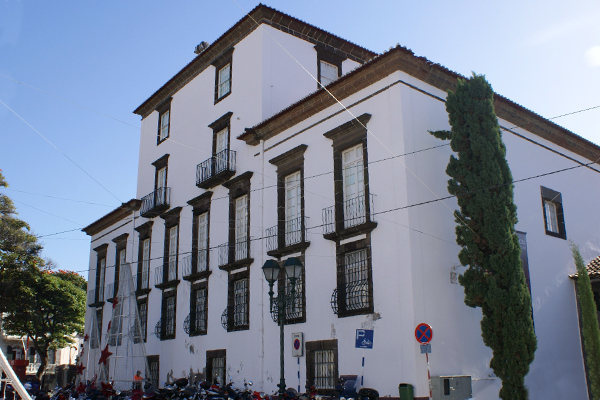 The Arte Sacra Museum of Funchal is located in the former Bishop's Palace, founded by D. Luis Figueiredo de Lemos, in 1594. It was designed by Jerome George, master of royal works, who worked here in the defences of the city of Funchal. From the original building, still survives a west section, over the Praça do Município and Rua do Bispo.
The Arte Sacra Museum of Funchal is located in the former Bishop's Palace, founded by D. Luis Figueiredo de Lemos, in 1594. It was designed by Jerome George, master of royal works, who worked here in the defences of the city of Funchal. From the original building, still survives a west section, over the Praça do Município and Rua do Bispo.
Sobriety Mannerist arches is visible in the north or in the Chapel of St. Luis de Toulousa, which has an inscription on the facade with the name of its founder, D. Luis Figueiredo Lemos and the date 1600. D. Antonio Teles da Silva, Bishop of Funchal, performed new works of improvement between 1675-1682. After the earthquake of 1748, major rebuilding works are performed, since it had been badly damaged. The new project for the Bishop's Palace was handed over to Dominic Rodrigues Martins. The assembly is then balanced by a central block, with the inscription on the main portal of 1750.
From 1910 until 1950, the Bishop's Palace would function as Lyceum of Funchal, and then again adapted to the Museum.
With the visit of the Palacio da Ajuda Curator, Manuel Cayola Zagallo, the awareness of the importance of Flemish Art scattered by the churches and chapels of the Diocese of Funchal gets more consistent. With the unequivocal support of the Bishop of Funchal, D. António Ribeiro Pereira and public entities then, the identified works were sent to Lisbon to restore. After major restoration and conservation work by Fernando Mardel, the paintings were exhibited in London at the National Museum of Ancient Art in 1949. They would later join the Sacred Art Museum of Funchal, opened in 1955. In this series, other works were added, mainly from Goldsmiths, Vestments and sculpture, mostly from Portuguese workshops, which were, in many cases concealed and in poor condition, kept in many churches in the diocese, which became part the collections of the Museum.
The highlights are set in two main groups: the Flemish Art with Painting, Sculpture and Jewellery, dated between the late fifteenth century and the early years of the sixteenth century and Portuguese Art, between the fifteenth century and the eighteenth century.
In Flemish Art and Painting, especially the wooden retables as Descent from the Cross, attributed to Gerard David, James, attributed to Dieric Bouts Adoration of the Magi attributed to the Master of the Adoration from Machico, The Annunciation and the Triptych of St. Peter, St. Paul and St. Andrew, attributed to Joos Van Cleve, or Mary Magdalene, the Wheels of Triptych from Calheta, attributed to Jan Provoost and the Triptych of St. James and St. Philip Minor, attributed to Pieter de Coeck Van Aelst . In Flemish sculpture highlighting Our Lady of Conception, from Machico, following the school of Malines, or of the Deposition in the Tomb. Note also an exceptional silver Tray, gilded and punctured, from Antwerp in the early sixteenth century.
From the collection of Portuguese art should be highlighted three key areas: Painting, Sculpture and Jewellery. In Painting, St. Benedict or St. Bonaventure (São Bento ou São Boaventura) in the late fifteenth century, the Ascension of Christ Fernao Gomes, and the Eleven Thousand (Onze Mil Virgens) of Martin Conrado. The Sculpture, in a wide range of works, from the mid-sixteenth to the eighteenth century, with special reference to San Sebastian (São Sebastião ) assigned to a Diogo-Pires-o-Moço, or the sculptural group of the dressing room that of Funchal Cathedral from the mid-seventeenth century, attributed to Manuel Pereira, or Queen Isabel of Portugal in the mid seventeenth century and Our Lady of Remédios in the mid eighteenth century.
In gold, it should be noted especially the Treasury of the Sé, the Cathedral of Funchal, with the exceptional Processional Cross, silver gilded, offered by D. Manuel I, King of Portugal in the second decade of the sixteenth century. Still an important Mannerist set of silverware Eucharistic Vessel and trays of various churches in the Diocese of Funchal or the amphora that of Funchal. From the Eighteenth-century, reference to the Urn of silver and gold Custody of the Cathedral of Funchal.
The Museum has a collection of vestments of the mid-seventeenth and eighteenth centuries, embroidered in gold and silver, with application of jewels.

